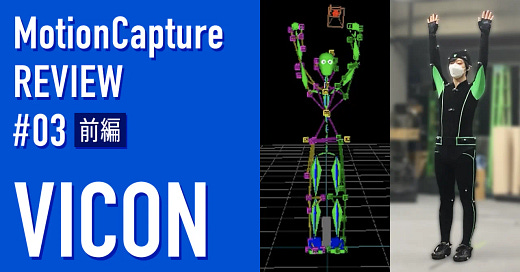Hello, this is Komatsu, Associate Technical Director at BASSDRUM.
For our third installment in the BASSDRUM motion capture review series, we will be focusing on VICON, a staple in the motion capture industry! Even if you're not technically inclined, you may have heard the name! We will review VICON from the perspective of a Technical Director, based on the following items!
Without further ado, let's get started!
※ All information in this article is as of May 2023.
Product Overview
Regarded as the "most accurate" in hardware comparison tests conducted worldwide, this is an optical* motion capture system.
With a history of over 30 years, it wouldn't be an exaggeration to say that it's the most widespread motion capture system.
Not only is it used for entertainment purposes, but due to its high accuracy, it's also adopted in medical facilities and academic institutions for research use.
(Refer to the domestic website (http://www.vicon.jp/))
*Optical: This method involves wearing what is known as retro-reflective markers all over the body. These markers are captured by infrared cameras and reconstructed as bones to capture motion information.
Price: Approximately 20 million yen for a complete set + alpha (This is just an example. The price varies greatly depending on the number of cameras installed and their specifications.)
How to use
Overall Evaluation
Accuracy: ★★★★★
Latency: ★★★★★
Ease of use: ★☆☆☆☆
Integration with other software: ★★★★☆
Price: ★☆☆☆☆
Advantages
Overwhelming accuracy
Adopted in numerous video productions, showing high reliability as a product
Disadvantages
Many steps are required to set up for accuracy. (Including studio calibration, ROM exercises, etc.)
A decent amount of specs can easily cost tens of millions of yen. (If it's a large-scale studio, it can cost billions.)
Some parts require a certain level of specialized knowledge to learn operations.
At the very least, you need an empty space of more than 10 tatami mats.
Setting up cameras is mandatory, making transportation difficult.
Who is it for?
Although this product involves a trade-off between the height of various hurdles and overwhelming accuracy, it may be a recommended product for those who want to "establish a motion capture studio and start a business" or "consistently create high-quality CG content in-house".
Accuracy ★★★★★
The accuracy is outstanding.
Since the absolute position is obtained using markers, we can confirm that there are no offsets, such as sinking into the floor during jumps.
Since it is optical-based, it should be relatively weak in blind spots, but it can capture without any problem if it's just sitting normally or cross-legged.
The accuracy tends to fluctuate depending on the placement of the cameras, but it seems that sufficient accuracy can be obtained if a general configuration is possible.
Verification environment:
VICON MX40 ×10
Blade
The movements tested this time are as follows:
Cheering (arms raised)
Crossed arms
Box step
Jumping
Sitting on the floor (cross-legged)
Sitting on the floor (gymnasium sit)
Sitting on the floor (formal sit)
Sitting in a chair (from standing to sitting, from sitting to standing)
Looking at it overall, wouldn't you say the accuracy is as close to perfect as possible?
As mentioned above, the accuracy can vary slightly depending on the number, specifications, and arrangement of cameras, but as long as the camera environment isn't vastly different from the size of the studio, you can capture motion of more than sufficient quality for entertainment purposes.
Latency ★★★★★
Approximately 10mS (around 0.01 seconds)
There is hardly any delay. However, a slight delay can be expected when recording multiple people simultaneously and sending the data to another software like MotionBuilder in real time.
Ease of Use ★☆☆☆☆
It requires a significant cost for all the necessary equipment, required space, and time and process for setup. As it can also be used for research purposes, there are many processes (like ROM exercises) to increase the accuracy to the limit, and it takes about 2 hours from the operator's entry to the studio to start motion capture.
Necessary equipment:
VICON-compatible camera (MX40, T10S, etc.)
VICON-compatible software (Blade, Shogun, etc.)
Suit & shoes
Markers (dozens to hundreds)
Camera installation equipment (truss, pole, etc.)
Minimum required space: at least 4m×4m of unoccupied space.
Required number of people (including actor): 2
Time required for setup (time until motion capture is possible): approximately 60 minutes
Studio calibration (process of letting the software recognize the camera position): approximately 10 minutes
Sensor attachment & link: 15 minutes
Calibration (process of letting the software recognize the markers worn by the actor): 20-30 minutes
Although Vicon and Crescent, the domestic sales agent, have published tutorials related to setup, the learning hurdle is not that high, but a certain amount of experience is required to the extent that the difference in proficiency between a familiar operator and a first-time operator is clearly visible.
Integration with Other Software ★★★★☆
Although it officially supports major software, the bar is higher for integration with various other software compared to Mocopi, hence the four-star rating.
[mocopi] Technical Director Reviews Motion Capture at a Glance #1
Officially supported software:
MotionBuilder, as well as numerous other plugins and software for research purposes. Using these plugins, it's possible to stream data directly from Vicon software (like Shogun and Blade) to UnrealEngine or Unity. However, the common workflow seems to involve sending data first to MotionBuilder for retargeting, and then streaming that data to other software.
Price ★☆☆☆☆
Purchase price:
VICON set: 20 million yen
Camera equipment: 3 million yen
Running costs:
Annual support: 1.5 million yen
Other maintenance costs
※ The cost of VICON can vary greatly depending on the equipment, the above is just an example.
With top-tier precision comes top-tier pricing, making it a considerable investment even for companies. The running costs are also significant, so a considerable commitment is required when considering the installation. (It seems that a single camera for the latest VICON model costs 9 million yen...)
We would like to thank Tetra Corporation for their cooperation in this verification!
Thank you, Tetra!




